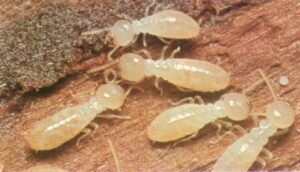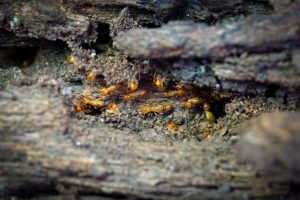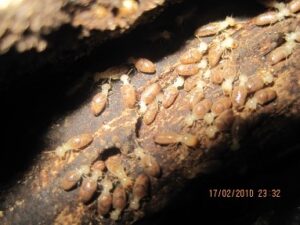Non-Subterranean Termites
Termites other than subterranean termites are divided into drywood and dampwood termites. Of these, drywood termites are the most common, and belong to the family Kalotermitidae, while the rotten and dampwood termites belong to the families Kalotermitidae, Termopsidae, and Rhinotermitidae.
A- Drywood Termites:
General Description
No published records on the drywood termite fauna of the UAE are available.
Life Cycle and Common Characteristics
- Drywood termites live (feed and nest) in structural wood that is not decayed and has a very low moisture content.
- Unlike subterranean termites, they do not require any contact with the soil to live. Therefore, they can seriously damage not only buildings but also movable wooden objects, such as furniture.
- A male and female pair (called alates) work their way into the wood chosen for the nest. The opening, through which they enter the, is sealed with a plug of brown cement-like material about 3 mm in diameter. They excavate, behind this plug, a chamber where the queen lays the first eggs.
- The nymphs (called larvae by some termite specialists) that hatch from these eggs go through a more complex metamorphosis (several stages) than subterranean termites before becoming soldiers and reproductives. These nymphs perform the work of the colony, and there is no distinct worker caste, as with subterranean termites.
- During the swarming season, nymphs make round holes (1.5–3.0 mm in diameter) through which the reproductive forms leave the wood. When swarming is complete, these holes are plugged in the same way as the original entrance holes.
Feeding Damage and Economic Implications
- The damage done by drywood termites is entirely different from that caused by subterranean termites. These termites cut across the grain of the wood, excavating large chambers connected by small tunnels. The chambers used by the colony are kept clean. Excreta and other debris are stored in unused chambers or cast out through small openings in the wood surface (openings called Kick-Out Holes).
- Excreted pellets are a distinguishing characteristic of non-subterranean termites. These pellets are hard and have six distinct concave surfaces on the sides; only the ends are rounded.
- Entrance into wood is usually made through a crack or crevice that termites can enter before boring into the wood.
- Because of their ability to live in wood without soil contact, non-subterranean termites are frequently carried in infested furniture and other wooden objects into geographical areas where they are not normally found.
- Drywood termites may attack wood products of all kinds, structural timbers and woodwork in buildings as well as furniture and other wooden objects may be damaged (less damage than subterranean termites).
B- Dampwood Termites
General Description
No published records on the dampwood termite fauna of the UAE are available.
Life Cycle and Common Characteristics
- The dampwood termite group contains some of the largest termites, with alates (winged termites) as much as 2.5 cm long with wings.
- These termites do not require contact with the soil to obtain moisture, but wood with a high degree of moisture is needed. They are usually associated with wood decay.
Feeding Damage and Economic Implications
- Dampwood termites plug openings into the wood and excavate galleries, as do drywood termites, but they do not keep the galleries clean.
- The termite pellets can be found throughout their tunnels in infested wood, although many of the six-sided pellets are discarded from the galleries through small openings in the surface of the wood. However, the pellets are only slightly six sided, and they lack the longitudinal ridges that give drywood termite pellets their characteristically sculptured appearance.




